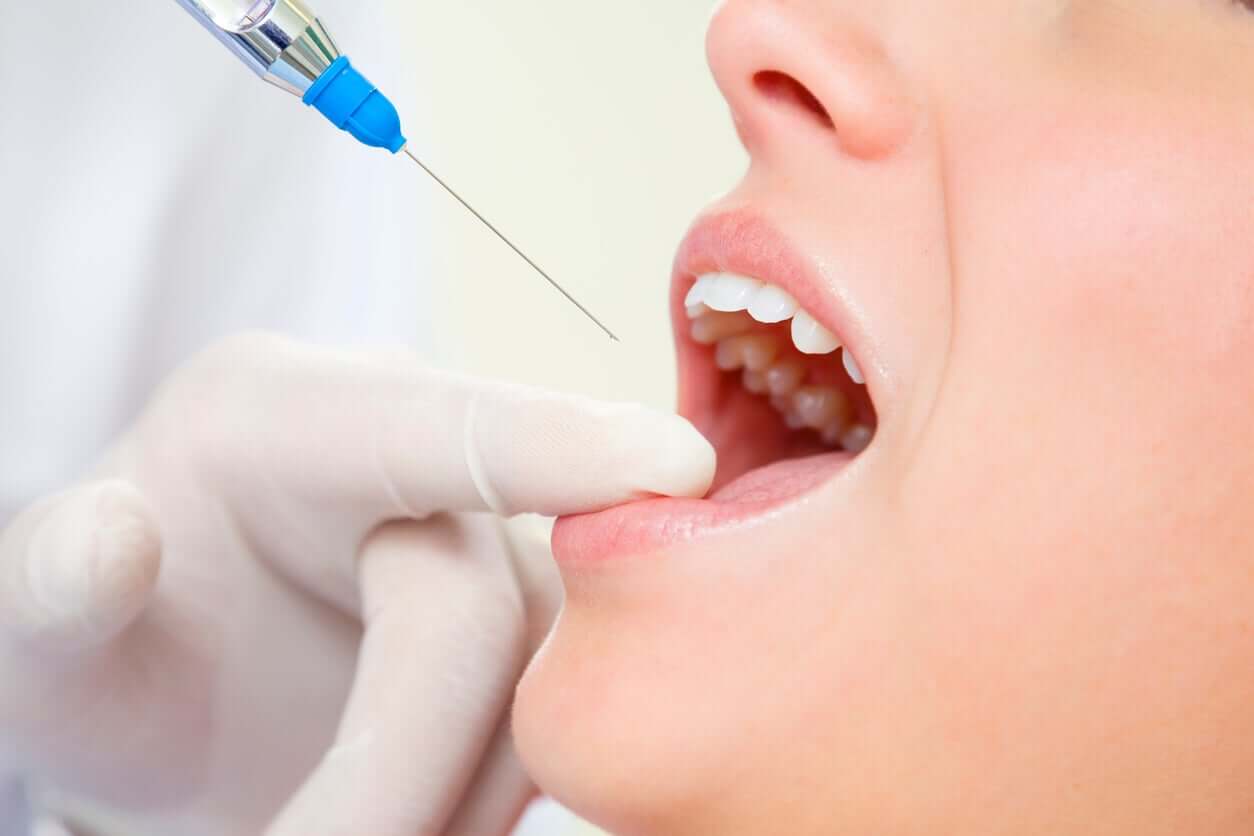Dental Anesthesia in Pregnancy: Are There Risks?

When future mothers are waiting for the arrival of their babies, they worry about taking care of their health, changing certain habits, and avoiding the consumption of harmful substances. Therefore, many women wonder if they can go to the dentist and receive dental anesthesia during pregnancy.
This doubt and the fear of using anesthetics in the mouth can lead many women to skip dental checkups or avoid emergency visits. Enduring pain, self-medicating, and neglecting oral health can be very risky for both mother and baby.
Neglecting your mouth during pregnancy is much more dangerous than getting an injection with dental anesthesia. Therefore, in this article, we’ll clarify everything you need to know about anesthetics during pregnancy and the importance of visiting the dentist at this stage.
Dental visits during pregnancy

You should know that experts recommend visits to the dentist before becoming pregnant and throughout pregnancy. The professional is trained to adequately accompany the entire process, without putting your little one’s health at risk.
Ideally, you should go to the dentist during pregnancy planning in order to perform all the necessary treatments and leave the mouth in optimal conditions before you conceive.
When the pregnancy is confirmed, the expectant mother must inform the professional about her condition and obtain the necessary advice to maintain the appropriate care of her mouth. In addition, if there’s any treatment to be carried out, it must be scheduled for the most opportune moment.
Generally speaking, it’s better to perform all dental procedures during the second trimester of pregnancy. By this time, the formation of the fetal organs has completed and the mother isn’t as uncomfortable as in recent months.
In the third trimester, in addition, there are more risks of inducing labor prematurely, so only urgent treatments that can’t be postponed should be performed. Appointments should be short and the professional should adapt the position of the chair to provide comfort and safety for the patient.
Just the same, as we already told you, visits during each of these stages are recommended. If your level of nausea allows, the dentist may consider it appropriate to perform a cleaning or a fluoride application at any point.
Dental emergencies
Everything we’ve mentioned refers to routine dental visits, but it’s worth clarifying that in the event of a dental emergency, the consultation shouldn’t be postponed.
When the expectant mother has pain, a large tooth decay, bleeding gums, suffers trauma, or has an infection, she should visit the dentist as soon as possible. If these conditions aren’t controlled in time, they can lead to serious complications.
If dental X-rays are required, they can be taken with adequate protection, after the first trimester is complete.
Dental anesthesia in pregnancy
Dental anesthesia is a procedure used during dental treatments to eliminate sensitivity in the area. This way, the patient doesn’t feel pain or discomfort while the professional works.
Specific medication is used that temporarily inhibits nerve conduction. Therefore, the painful sensation is blocked for the time necessary to perform the procedure.
The use of dental anesthesia during pregnancy is safe, as it involves substances that aren’t toxic to the baby and in very small doses. However, its use is limited to emergencies and treatments that can’t be postponed during this stage.
In dentistry, it’s common to use anesthetics that contain a vasoconstrictor effect (which constricts the blood vessels), to increase the duration of the anesthetic effect and reduce bleeding in the area.
With regard to these medications during pregnancy, there are conflicting opinions and many professionals opt for anesthetics without vasoconstrictors at this stage.

Trust the professional
As you can see, the use of dental anesthesia during pregnancy is safe and is indicated, preferably, during the second trimester of pregnancy.
You must remember that it’s more beneficial to go to the dentist to treat pain, an infection, or a cavity, than to endure suffering or self-medicate. Postponing the care of your mouth can cause complications in pregnancy, cause a much greater oral injury, or even the loss of the dental element.
Visiting the dentist before and during pregnancy will allow you to take care of your oral health throughout this stage. It’s important to remind the professional of your state of pregnancy and follow their instructions in order to maintain a healthy smile while you wait for your baby.
When future mothers are waiting for the arrival of their babies, they worry about taking care of their health, changing certain habits, and avoiding the consumption of harmful substances. Therefore, many women wonder if they can go to the dentist and receive dental anesthesia during pregnancy.
This doubt and the fear of using anesthetics in the mouth can lead many women to skip dental checkups or avoid emergency visits. Enduring pain, self-medicating, and neglecting oral health can be very risky for both mother and baby.
Neglecting your mouth during pregnancy is much more dangerous than getting an injection with dental anesthesia. Therefore, in this article, we’ll clarify everything you need to know about anesthetics during pregnancy and the importance of visiting the dentist at this stage.
Dental visits during pregnancy

You should know that experts recommend visits to the dentist before becoming pregnant and throughout pregnancy. The professional is trained to adequately accompany the entire process, without putting your little one’s health at risk.
Ideally, you should go to the dentist during pregnancy planning in order to perform all the necessary treatments and leave the mouth in optimal conditions before you conceive.
When the pregnancy is confirmed, the expectant mother must inform the professional about her condition and obtain the necessary advice to maintain the appropriate care of her mouth. In addition, if there’s any treatment to be carried out, it must be scheduled for the most opportune moment.
Generally speaking, it’s better to perform all dental procedures during the second trimester of pregnancy. By this time, the formation of the fetal organs has completed and the mother isn’t as uncomfortable as in recent months.
In the third trimester, in addition, there are more risks of inducing labor prematurely, so only urgent treatments that can’t be postponed should be performed. Appointments should be short and the professional should adapt the position of the chair to provide comfort and safety for the patient.
Just the same, as we already told you, visits during each of these stages are recommended. If your level of nausea allows, the dentist may consider it appropriate to perform a cleaning or a fluoride application at any point.
Dental emergencies
Everything we’ve mentioned refers to routine dental visits, but it’s worth clarifying that in the event of a dental emergency, the consultation shouldn’t be postponed.
When the expectant mother has pain, a large tooth decay, bleeding gums, suffers trauma, or has an infection, she should visit the dentist as soon as possible. If these conditions aren’t controlled in time, they can lead to serious complications.
If dental X-rays are required, they can be taken with adequate protection, after the first trimester is complete.
Dental anesthesia in pregnancy
Dental anesthesia is a procedure used during dental treatments to eliminate sensitivity in the area. This way, the patient doesn’t feel pain or discomfort while the professional works.
Specific medication is used that temporarily inhibits nerve conduction. Therefore, the painful sensation is blocked for the time necessary to perform the procedure.
The use of dental anesthesia during pregnancy is safe, as it involves substances that aren’t toxic to the baby and in very small doses. However, its use is limited to emergencies and treatments that can’t be postponed during this stage.
In dentistry, it’s common to use anesthetics that contain a vasoconstrictor effect (which constricts the blood vessels), to increase the duration of the anesthetic effect and reduce bleeding in the area.
With regard to these medications during pregnancy, there are conflicting opinions and many professionals opt for anesthetics without vasoconstrictors at this stage.

Trust the professional
As you can see, the use of dental anesthesia during pregnancy is safe and is indicated, preferably, during the second trimester of pregnancy.
You must remember that it’s more beneficial to go to the dentist to treat pain, an infection, or a cavity, than to endure suffering or self-medicate. Postponing the care of your mouth can cause complications in pregnancy, cause a much greater oral injury, or even the loss of the dental element.
Visiting the dentist before and during pregnancy will allow you to take care of your oral health throughout this stage. It’s important to remind the professional of your state of pregnancy and follow their instructions in order to maintain a healthy smile while you wait for your baby.
All cited sources were thoroughly reviewed by our team to ensure their quality, reliability, currency, and validity. The bibliography of this article was considered reliable and of academic or scientific accuracy.
- Bozzo, R. B., & Quiroga, H. J. L. (2021). manejo anestésico de la paciente de urgencia embarazada. Rev Chil Anest, 50, 171-195.
- Sano, J., Colmenares, N., Sakkal, A., Cedillo, M., & Duran, C. (2001). Anestesia local odontológica y embarazo. Acta Odontológica Venezolana, 39(2), 61-63.
- Rodrigues, F., Mármora, B., Carrion, S. J., Rego, A. E. C., & Pospich, F. S. (2017). Anestesia local em gestantes na odontologia contemporânea/Local anesthesia in pregnant women in contemporary dentistry/La anestesia local en mujeres embarazadas en la odontología contemporánea. Journal Health NPEPS, 2(1), 254-271.
- Ramírez, I. H. G., Juárez, M. D. N., & de la Torre, B. N. (2019). Tratamiento dental más atendido en pacientes embarazadas que acudieron a Centro de Atención Médica Integral, período 2018 A. Revista Mexicana de Estomatología, 6(1), 55-56.
- Lomas Delgado, G. A. (2021). Conocimiento de las gestantes sobre la relación entre enfermedades bucodentales y complicaciones del embarazo (Bachelor’s thesis, Universidad de Guayaquil. Facultad Piloto de Odontología).
- Martínez Menchaca, H. R., Escamilla Ocañas, C. E., Noyola, A. S., & Treviño Alanís, M. G. (2012). Directriz para el cuidado oral durante el embarazo. Revista ADM, 69(1).
- Suárez, J. L. C., & Guzmán, L. M. D. (2009). Embarazo, enfermedades sistémicas de alto riesgo y enfermedad periodontal. Perinatología y Reproducción humana, 23(2), 65-73.
- García, O. M. F., & Medrano, M. G. C. (2010). Atención odontológica en la mujer embarazada. Archivos de investigación materno infantil, 2(2), 80-84.
- Hernández, A. L., & Montealegre, C. S. (2016). Manejo odontológico de mujeres embarazadas. Archivos de Investigación Materno Infantil, 8(3), 105-112.
This text is provided for informational purposes only and does not replace consultation with a professional. If in doubt, consult your specialist.








